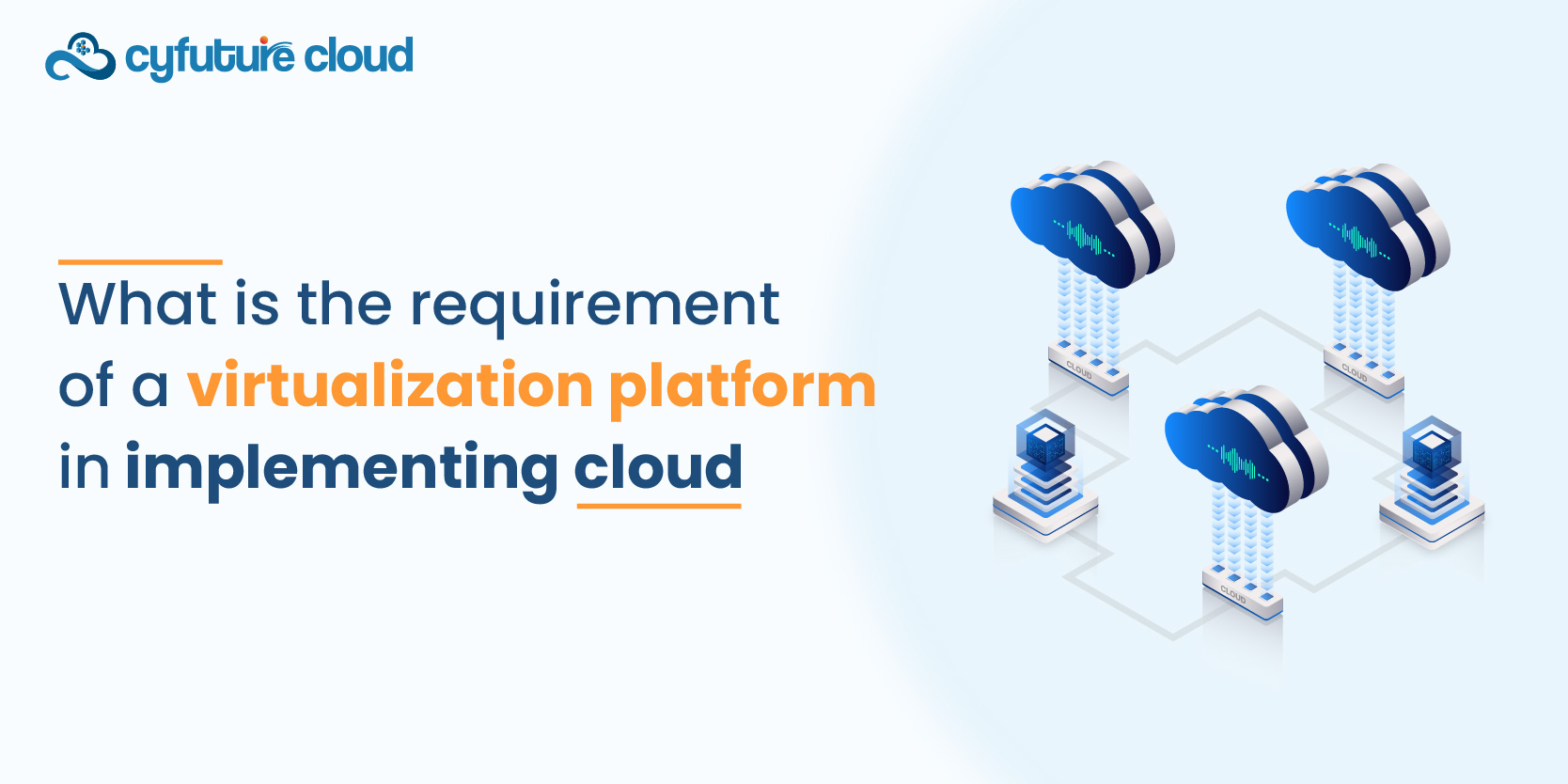
Is virtualization necessary for cloud computing? In this knowledge base, we will discuss this today.
Virtualization platforms are critical in cloud computing applications because they enable optimal resource utilization, scalability, and flexibility of cloud services. This knowledge base delves into the essential need for virtualization in cloud computing implementation, discussing its significance, types, benefits, and challenges.
By going through this KB, readers will get to understand about how virtualization serves as the foundation for contemporary cloud computing solutions and how to define virtualization in cloud computing.
Introduction:
Cloud computing has changed the way firms provide and use information technology resources. The virtualization principle, which allows several virtual instances to run on a single server, lies at the heart of cloud computing. This knowledge base digs into the vital role of virtualization platforms in cloud computing systems, covering its benefits, requirements, issues, and future improvements.
Defining Cloud Computing:
In this subsection, the document will likely provide a clear scenario of how to define cloud computing. Cloud computing is the distribution of different computer services, such as storage, processing power, networking, and others, through the internet. Users can access and use these resources as required from faraway data centres rather than owning and maintaining actual gear and software.
The Role of Virtualization Platforms:
The purpose of virtualization divides a single physical server into several virtual machines(VMs), and each VM is assigned with an operating system and applications. Because it enables for maximum resource utilisation and the separation of multiple user contexts on the same physical hardware, virtualization is an important component of cloud computing
Purpose and Scope:
This section of the introduction clarifies the document or presentation's aims and constraints. It describes the document's goals and the precise parts of the topic it will address. It assists the reader in understanding the scope of the material offered and establishes expectations for the depth and breadth of the content.
Virtualization Platforms: An Overview:
The virtualization platform is a fundamental notion in contemporary computing that has dramatically altered the way resources are handled and utilised. This section gives a thorough review of virtualization, its numerous kinds, and various uses in the context of cloud computing.
What is Virtualization?
The process of creating a virtual (simulated) version of a resource is known as Virtualization, such as operating system, a storage device, server, or network, within a physical environment. The purpose of virtualization is to encapsulate the underlying physical hardware such that several virtual instances can run independently on a single physical machine.
This abstraction allows for efficient resource utilization, isolation, and flexibility. By separating the virtual from the physical, virtualization enables greater agility in managing resources and offers a wide range of benefits for various IT environments.
Types of Virtualization
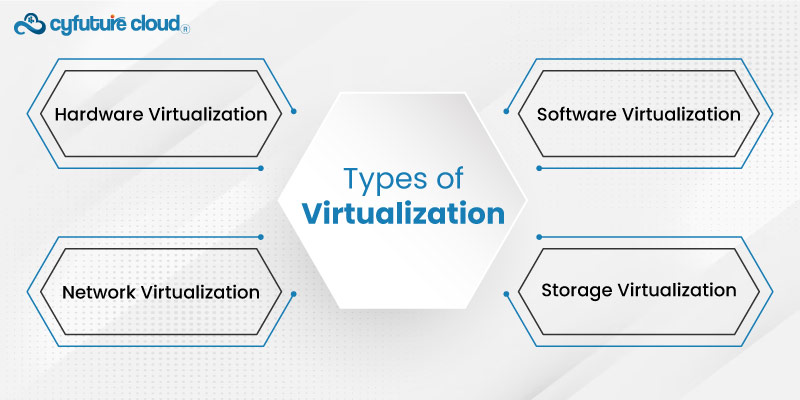
Virtualization may be classified into several forms based on the characteristics of the computer resources that are virtualized. These kinds include numerous technologies and approaches that contribute to resource efficiency and the establishment of a more flexible computer environment.
Hardware Virtualization
The process of establishing several VMs on a single physical server is known as hardware virtualization, sometimes known as server virtualization. Each VM is a self-contained computer environment with its own operating system, software, and resources. Hypervisor software supervises and provides resources to virtual machines, such as Microsoft's Hyper-V, VMware's vSphere, or KVM.
This type of virtualization maximises server resources by allowing many workloads to run on the same physical computer, resulting in enhanced resource efficiency, hardware consolidation, and easier management.
Software Virtualization
The goal of software virtualization, also known as application virtualization, is to separate individual software programmes from the underlying operating system and hardware. This isolation eliminates application conflicts and allows apps to operate freely in their own virtual environments. Containerization is used by application virtualization systems such as Docker and Kubernetes to bundle applications and their dependencies, making them portable and easy to deploy across diverse environments.
Network Virtualization
Network virtualization isolates network resources from their physical equivalents, such as switches, routers, and firewalls. This enables the establishment of virtual networks that run independently of the physical infrastructure. Network virtualization is very beneficial in cloud settings since it allows for the dynamic allocation and control of network resources for various tenants or applications. Network virtualization options include VMware's NSX and Cisco's Application Centric Infrastructure (ACI).
Storage Virtualization
Storage virtualization separates storage resources from physical hardware, such as discs and storage arrays, allowing for centralised control and allocation of storage space. Storage virtualization allows several storage devices to be displayed as a single storage pool, simplifying storage administration and increasing scalability. This type of virtualization is essential for achieving efficient data management and data mobility within cloud environments.
Requirements of Virtualization Platforms in Cloud Implementation:
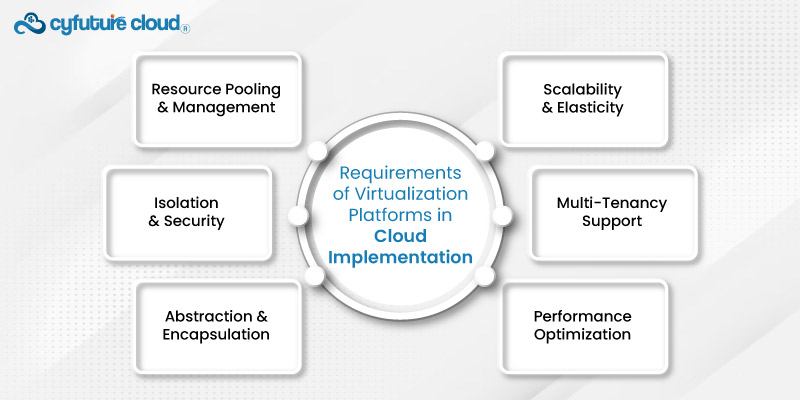
Virtualization platforms must fulfil particular requirements to enable optimal resource utilisation, security, scalability, and overall performance for a successful cloud implementation. This section goes into the most important requirements that virtualization platforms must meet while supporting cloud environments.
Resource Pooling and Management
Resource pooling involves aggregating physical resources, such as processing power, memory, and storage, into a shared pool. Virtualization platforms need to effectively manage this pooled resource pool and allocate it to virtual instances based on demand. This dynamic allocation ensures that resources are utilized optimally and eliminates resource wastage. Resource management mechanisms, such as load balancing and resource reservation, help maintain consistent performance across virtual instances and enable efficient utilization of underlying hardware.
Isolation and Security
Isolation is a critical requirement in virtualization platforms to prevent interference between different virtual instances. Each virtual instance should operate independently of others, ensuring that activities in one instance do not affect the performance or security of others. Isolation is crucial for achieving data confidentiality, integrity, and availability. Virtualization platforms implement mechanisms such as hypervisor-based isolation and hardware-enforced security features to prevent unauthorized access and malicious activities.
Abstraction and Encapsulation
Abstraction allows cloud users to interact with virtual instances without needing to know the underlying physical details. Virtualization platforms abstract the complexities of hardware, operating systems, and networking, providing users with a simplified and consistent interface. Encapsulation further enhances this abstraction by packaging virtual instances with their associated configurations and dependencies. This encapsulation makes virtual instances portable and easy to migrate across different physical hosts, enhancing flexibility and reducing downtime during maintenance or failures.
Scalability is the ability of a virtualization platform to accommodate an increasing number of virtual instances or resources as demand grows. Elasticity extends scalability by automatically adjusting resources in response to varying workloads. Virtualization platforms must provide mechanisms for dynamic scaling, allowing resources to be allocated or deallocated based on real-time demand. This ensures that cloud services can handle fluctuating workloads efficiently while minimizing overprovisioning or underutilization.
Multi-Tenancy Support
Multi-tenancy is a crucial requirement for cloud environments, where multiple tenants (users or organizations) share the same physical infrastructure. Virtualization platforms need to isolate and secure the resources of different tenants to prevent unauthorized access and data leakage. Each tenant should have its own virtualized environment with dedicated resources and customized configurations. Role-based access controls, network isolation, and resource quotas are implemented to ensure the separation and fair distribution of resources among tenants.
Performance Optimization
Performance optimization is essential to ensure that virtual instances operate efficiently and meet the performance expectations of cloud users. Virtualization platforms must minimize the overhead introduced by virtualization, such as the performance impact of hypervisors. Technologies like paravirtualization and hardware-assisted virtualization aim to reduce this overhead.
Additionally, resource allocation and management mechanisms should be fine-tuned to allocate resources based on workload requirements, avoiding bottlenecks and ensuring consistent performance.
Benefits of Virtualization Platforms in Cloud Implementation:
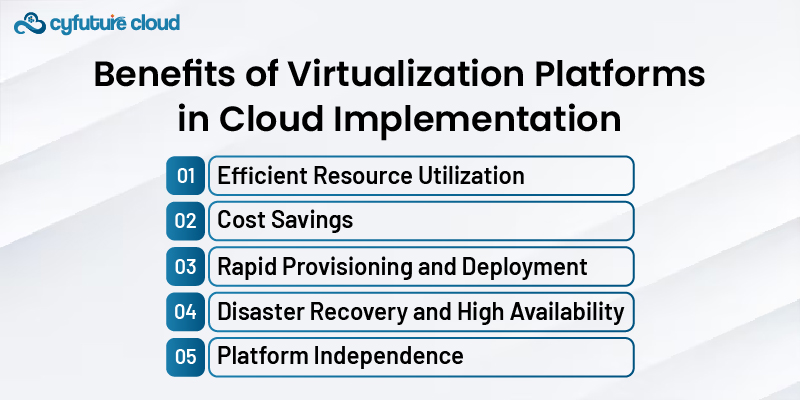
Virtualization platforms offer a multitude of benefits when applied in cloud implementation. These advantages contribute to enhanced resource management, cost-effectiveness, agility, and overall performance within cloud computing environments. This section explores the significant benefits that virtualization platforms bring to cloud implementation.
Efficient Resource Utilization
One of the primary benefits of virtualization platforms in cloud computing is efficient resource utilization. By abstracting physical hardware and creating virtual instances, these platforms enable multiple workloads to share the same physical resources. This resource pooling prevents resource underutilization and leads to higher efficiency. Workloads with varying resource demands can coexist on the same physical server, making better use of available processing power, memory, and storage. As a result, organizations can maximize their investment in hardware and reduce wastage.
Cost Savings
Virtualization platforms drive substantial cost savings in cloud implementation. By consolidating multiple virtual instances onto fewer physical servers, organizations can reduce the number of servers they need to purchase, maintain, and power. This hardware consolidation leads to lower capital expenditures (CAPEX) as well as reduced operational expenditures (OPEX) related to data center space, cooling, and power consumption. The ability to optimize resource utilization also contributes to cost savings by avoiding overprovisioning.
Rapid Provisioning and Deployment
Virtualization platforms enable rapid provisioning and deployment of virtual instances. Traditional physical server provisioning can be time-consuming, involving manual installation and configuration. In contrast, virtual instances may be instantly constructed and deployed using pre-configured templates. This agility speeds up the process of establishing new services or apps, allowing organisations to adapt to changing business needs and market demands more quickly.
Disaster Recovery and High Availability
Virtualization platforms enhance disaster recovery and high availability strategies within cloud environments. Virtual machine snapshots and replicas can be taken, allowing for quick recovery in case of hardware failures or data corruption. These snapshots can be stored offsite, enhancing data protection.
Additionally, virtual instances can be live-migrated between physical hosts, minimizing downtime during hardware maintenance or failures. This capability ensures that cloud services remain available and responsive, even in the face of unexpected events.
Platform Independence
Virtualization platforms promote platform independence, allowing applications to run across different operating systems and hardware configurations. This compatibility is particularly beneficial when migrating applications or services between different cloud providers or environments. Organizations are not tied to specific hardware or software configurations, enabling them to make strategic decisions based on business needs rather than technical constraints.
Challenges and Considerations:
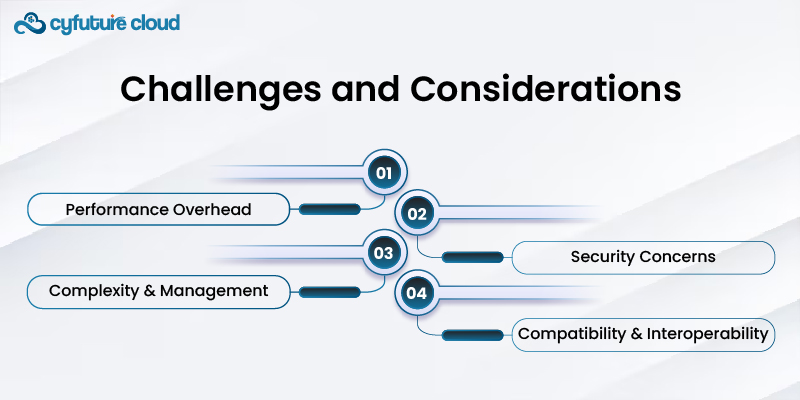
Implementing virtualization platforms in cloud computing environments brings forth a set of challenges and considerations that need to be carefully addressed. These challenges can impact performance, security, management, and overall compatibility. This section delves into the key challenges associated with the need for virtualization in cloud computing and offers insights into how to navigate them effectively.
Performance Overhead
One of the central challenges of virtualization in the cloud is the potential performance overhead introduced by the virtualization layer. The hypervisor, which manages virtual instances, can add a layer of abstraction that slightly impacts the performance of virtualized workloads compared to running directly on physical hardware.
This overhead can be more pronounced in scenarios with high-performance workloads that demand low-latency processing. Careful resource allocation, hardware acceleration, and optimization techniques are essential to mitigate this performance impact and ensure that cloud services meet performance expectations.
Security Concerns
Security is a critical consideration when implementing virtualization platforms in the cloud. The shared nature of virtualized environments raises concerns about the potential for unauthorized access, data breaches, and attacks that target virtualization vulnerabilities. The isolation mechanisms within the virtualization layer need to be robust to prevent one virtual instance from compromising the security of others. Security best practices, such as regular patching, network segmentation, and encryption, are crucial to maintaining the integrity and confidentiality of cloud services.Complexity and Management
While virtualization platforms offer numerous benefits, they can also introduce complexity to cloud environments. Managing a large number of virtual instances, configuring network connections, and monitoring resource usage can become challenging tasks. Organizations need to invest in management tools and practices that simplify the administration of virtualized resources. Automation, orchestration, and monitoring solutions help streamline management processes, reducing the potential for errors and ensuring efficient resource allocation.
Compatibility and Interoperability
Ensuring compatibility and interoperability across different virtualization platforms and cloud services can be a complex endeavor. Migrating virtual instances between different virtualization solutions or cloud providers may require adjustments and conversions to address differences in virtualization technologies, formats, and configurations. Organizations should consider strategies that prioritize portability and standardization to facilitate seamless migration and minimize vendor lock-in.
Virtualization Platforms in Leading Cloud Services:
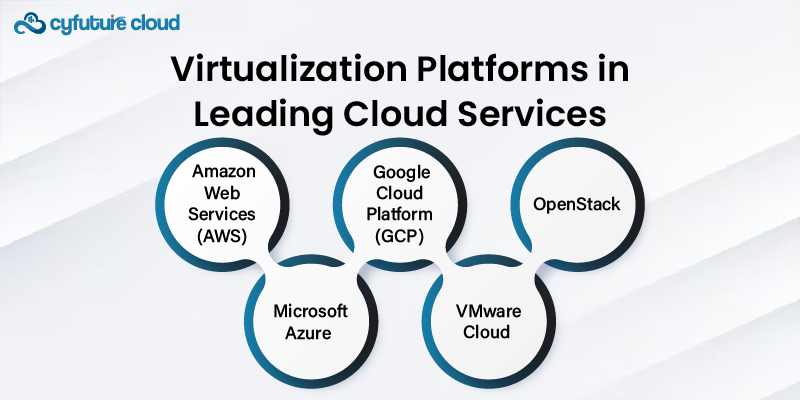
Leading cloud service providers have embraced virtualization platforms as a cornerstone of their infrastructures, enabling them to deliver efficient, scalable, and reliable cloud solutions. This section explores how virtualization is implemented in some of the most prominent cloud services available today.
Amazon Web Services (AWS)
Amazon Web Services (AWS) leverages virtualization extensively to power its cloud services. AWS employs the Xen hypervisor to create and manage virtual instances, enabling customers to launch a wide range of virtual machines based on their requirements. With features like Amazon EC2 (Elastic Compute Cloud), AWS provides resizable compute capacity in the cloud, allowing users to scale their virtual instances up or down as needed. Additionally, AWS offers various instance types optimized for different workloads, further enhancing resource utilization and performance.
Microsoft Azure
Microsoft Azure utilizes its own hypervisor, Hyper-V, to implement virtualization within its cloud infrastructure. Azure Virtual Machines enable users to deploy a variety of virtualized instances, offering flexibility and scalability. Azure also integrates with features such as Azure Virtual Machine Scale Sets, which automatically adjust the number of virtual instances based on demand. Azure's hybrid capabilities, like Azure Arc, extend virtualization beyond the cloud, allowing organizations to manage and deploy virtualized resources across on-premises and cloud environments seamlessly.
Google Cloud Platform (GCP)
Google Cloud Platform (GCP) employs the open-source KVM (Kernel-based Virtual Machine) hypervisor to virtualize its infrastructure. GCP provides a range of virtual machine offerings, including Google Compute Engine instances, designed to deliver reliable and high-performance computing resources. Google's focus on containerization and Kubernetes orchestration complements its virtualization efforts, allowing users to manage and deploy applications in a containerized environment, further enhancing scalability and flexibility.
VMware Cloud
VMware Cloud builds upon VMware's extensive experience in virtualization technology to deliver cloud services. VMware's virtualization solutions, such as VMware vSphere and VMware vCenter, enable organizations to seamlessly extend their on-premises virtualized environments to the cloud. With VMware Cloud on AWS and other offerings, users can run VMware-based workloads on cloud infrastructure while maintaining compatibility with their existing virtualization setups.
OpenStack
OpenStack is an open-source cloud computing platform that incorporates virtualization to provide a flexible and customizable cloud environment. OpenStack offers various modules for compute (Nova), networking (Neutron), and storage (Cinder), each implementing virtualization technologies to deliver comprehensive cloud services. OpenStack's flexibility allows organizations to build private, public, or hybrid clouds using a combination of virtualization technologies like KVM and Xen.
Emerging Trends and Future Directions:
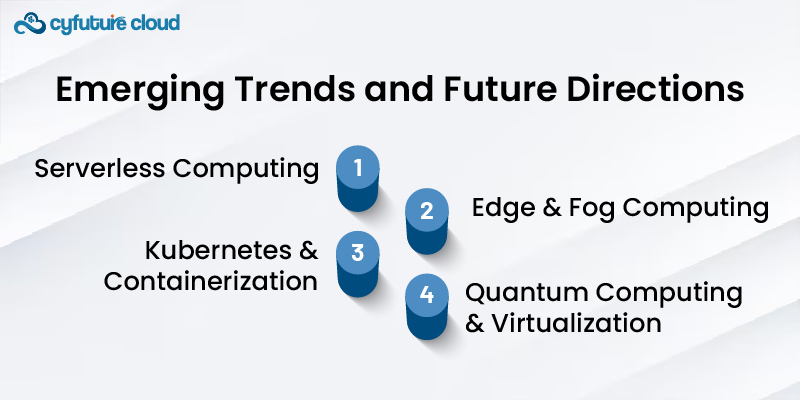
The landscape of virtualization and cloud computing is continuously evolving, driven by technological advancements and changing business needs. This section explores several emerging trends and future directions that are shaping the intersection of virtualization and cloud computing.
Serverless Computing
Serverless computing is a paradigm that takes virtualization and cloud services to the next level of abstraction. In serverless architectures, developers focus on writing code without concerning themselves with the underlying infrastructure. Cloud providers manage the allocation of resources, scaling, and execution of functions in response to events.
This trend minimizes the need for users to manage virtual instances directly, leading to improved resource utilization, reduced operational overhead, and enhanced scalability. Serverless computing empowers developers to focus solely on coding and delivering value while the cloud provider handles the intricacies of resource provisioning.
Edge and Fog Computing
Edge and fog computing are extensions of cloud computing that bring computation closer to data sources and end-users. Virtualization plays a crucial role in enabling these paradigms by creating virtual instances at the edge, allowing for localized processing and data analysis. This reduces latency, enhances real-time processing capabilities, and optimizes bandwidth usage. Virtualized resources at the edge can be provisioned dynamically to cater to the specific needs of nearby devices or applications, making edge and fog computing more efficient and responsive.
Kubernetes and Containerization
Kubernetes and containerization have become dominant forces in modern application deployment and management. While not strictly virtualization technologies, they share the same goals of efficient resource utilization and isolation. Containers contain applications and their dependencies, allowing them to run in a variety of settings.
Kubernetes, as an orchestrator, automates the deployment, scaling, and management of containerized applications. This trend enhances agility, accelerates development cycles, and supports microservices architectures, which are highly modular and scalable.
Quantum Computing and Virtualization
Quantum computing is an emerging field that promises to revolutionize computing by solving complex problems that are practically infeasible for classical computers. Virtualization is expected to play a role in quantum computing by enabling the creation of virtualized quantum environments. This would allow researchers and developers to experiment with quantum algorithms and simulations without needing access to physical quantum hardware. Virtualized quantum environments can accelerate the development of quantum applications and help bridge the gap between theory and practical implementation.
Conclusion:
As cloud computing continues to transform industries, virtualization platforms remain essential for harnessing its full potential. This concluding section summarizes the key points discussed in the knowledge base and emphasizes the enduring importance of virtualization in the dynamic landscape of cloud computing.
In conclusion, the integration of virtualization platforms into cloud computing infrastructure is a fundamental requirement that underpins the success of modern cloud services. Understanding the intricacies of virtualization's role, its requirements, benefits, challenges, and future trends is crucial for individuals and organizations aiming to leverage cloud computing effectively and efficiently.

Let’s talk about the future, and make it happen!